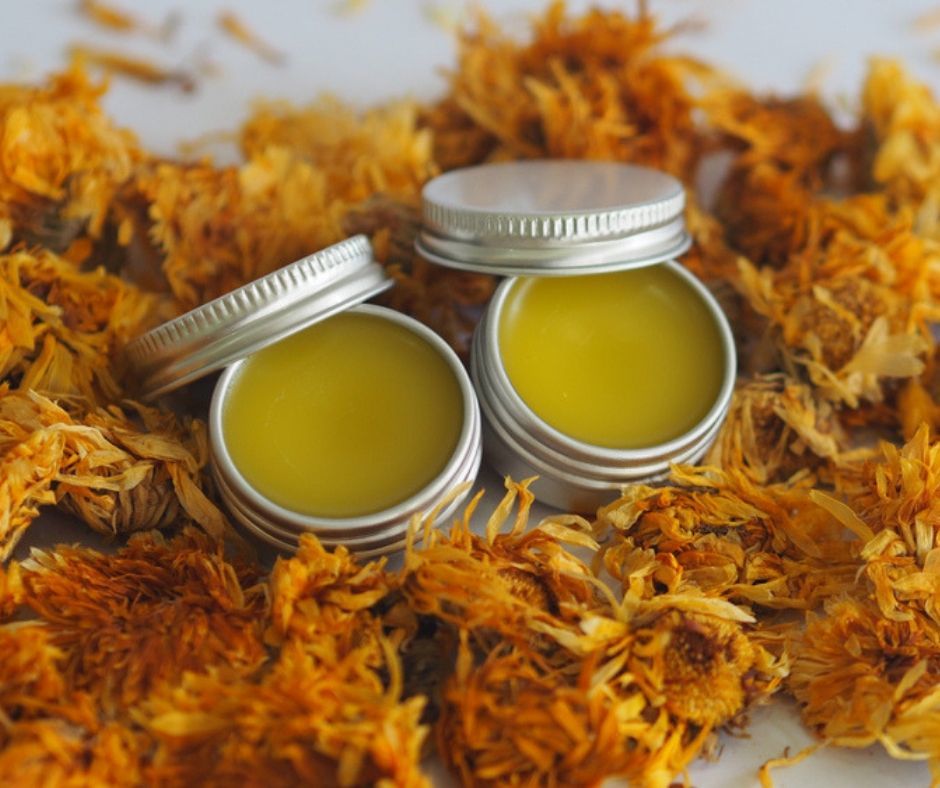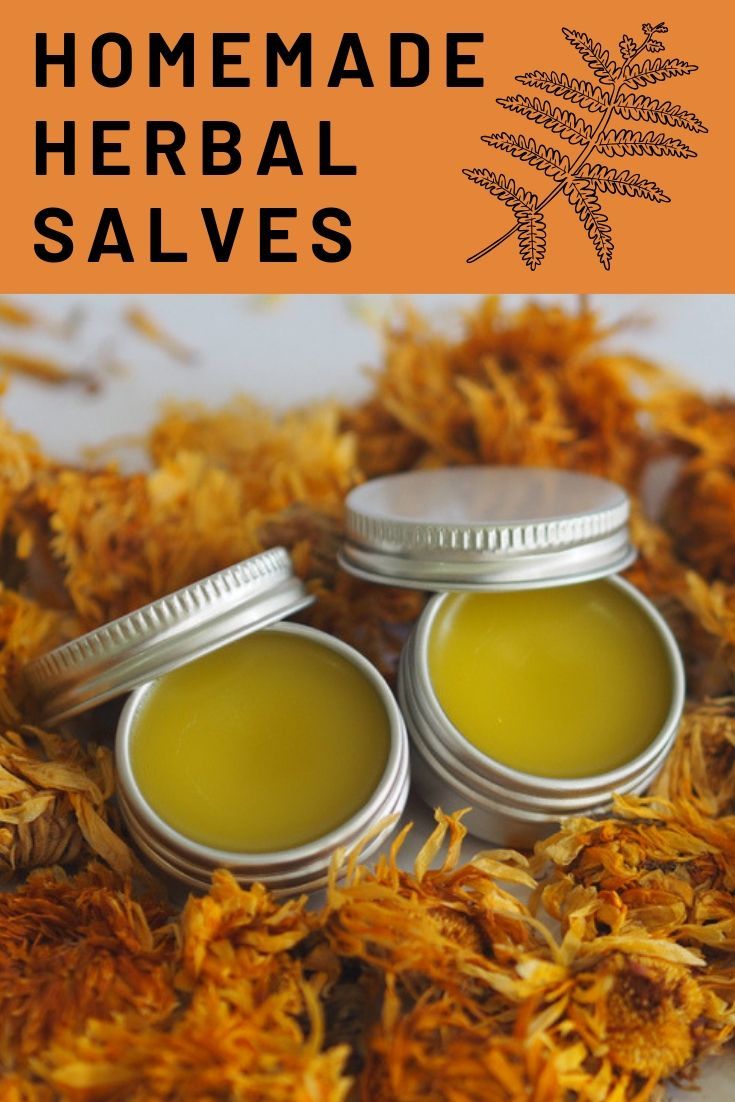
Herbal salves are great products to have in your home apothecary. And they are easy to make! You will need just a few basic ingredients to make an herbal salve base. Use this base to make some home remedies that you’ll use time and time again.
This is a quick guide to herbal salve making, followed by five recipes to try!
What Is An Herbal Salve?
A basic herbal salve is simply a blend of two ingredients, with the addition of essential oils and/or herbs. A true herbal salve will use an herb-infused oil (see below for further information) but you can also use many of the basic carrier oils used in aromatherapy; for example, sunflower (Helianthus annuus), sweet almond (Prunus dulcis), apricot and kernel (Prunus armeniaca) oils. More advanced herbal salves, using aromatherapy carrier oils, may contain borage (Borago officinalis), rosehip (Rosa rugosa), or evening primrose (Oenothera biennis) oil. However, you need to have an understanding of these carrier oils to adapt how much of each one you would combine in an herbal salve.
How To Make The Basic Salve
What You Will Need:
Beeswax (Cera alba) + herb-infused oil/carrier oil (+ essential oils)*
OR if you are making a vegan herbal salve you will need:
Carnauba wax (Copernica cerifera)** + herb-infused oil/carrier oil (+ essential oils)*
*essential oils are optional, depending upon what the salve is being made for.
** carnauba wax is a wax derived from the leaves of the Brazilian palm tree. It is not the same tree from which palm oil is derived.
Beeswax and carnauba wax are hard, solid waxes but note that carnauba wax is harder than beeswax. You’ll need to take this into account when making recipes and adjust accordingly.
The Method:
Which can be used to make all of the recipes provided in this article:
- Place the beeswax/carnauba wax in a Pyrex® jug.
- Heat up regular tap water in a small pan until it is hot enough to start melting the ingredients.
- Place the Pyrex® jug with the beeswax/carnauba wax into the pan containing the water. The jug should rest just above the water (attach the handle on the side of the pan) so that the steam from the water will start to melt the ingredients.**
- Once the beeswax/carnauba wax is melted, stir in the herb-infused oil or carrier oil and immediately take the Pyrex® jug off the heat.
- At this point add in and stir together the essential oil blend you’ve created (see recipes below).
- Pour the finished salve into salve tins or glass jars, before the mix starts to solidify.
- Place the lids on the salve tins or jars and place them in the refrigerator or a cool place to solidify. Keep the salve in a (cool) place where the temperature is constant so that the salve doesn’t continually melt and solidify.
*These instructions are adapted from my own work in making herbal salves.
**This is called the double boiler or Bain Marie method.
Using Herb-infused Oils In An Herbal Salve
If you want to add an herb-infused oil to the salve, some of the most common plants used are:
- Calendula (Calendula officinalis): for skin inflammation and bruises
- St. John’s Wort (Hypericum perforatum): for burns and rheumatoid arthritis
- Carrot (Daucus carota): for itchy skin and eczema.
You can also infuse almost any type of herb into a base oil to create an herb-infused oil, as discussed in a previous article here – How To Make Herb Infused Oils & 3 Recipes To Try
5 Simple Recipes For Herbal Salves
The following recipes use beeswax. If you want to make a vegan herbal salve, you’ll need to substitute the beeswax ingredient with carnauba wax. However, unless you want the salve to be rock hard, you’ll probably need to use less carnauba wax than that specified for beeswax.
These recipes also use a ratio of 6:1. You can take a salve recipe up to a ratio of 8:1, if you want a more fluid salve. Alternatively, you can take it down to a ratio of 2:1 if you like a really hard salve.
Lastly, these recipes use either an herbal-infused oil or a basic carrier oil. More complex carrier oils can be used but you would need to formulate a different recipe, based on the viscosity of the individual carrier oil.
All of these recipes have been formulated for adult use only, unless specified otherwise.
1. Aches & Pain Herbal Salve
Ingredients:
6-oz. apricot kernel (Prunus armeniaca) oil
1-oz. beeswax (Cera alba)
10 drops peppermint (Mentha × piperita) essential oil
15 drops rosemary (Rosmarinus officinalis) essential oil
10 drops clary sage (Salvia sclarea) essential oil
Add the essential oils to a glass beaker and mix well. Add the essential oil blend to the beeswax and apricot kernel oil as instructed above under How to Make the Basic Salve.
To Use:
Apply to point of pain twice a day. This is a potent blend and should be used sparingly. Stop use immediately if adverse reactions occur.
Cautions:
Avoid use around and with babies and children. Avoid use in pregnancy. Avoid use in epilepsy. Avoid use with high blood pressure. Possible skin sensitivity.
2. Herbal Salve For Burns
Ingredients:
6-oz. St. John’s wort (Hypericum perforatum) oil
1-oz. beeswax (Cera alba)
10 drops helichrysum (Helichrysum angustifolia) essential oil
20 drops lavender (Lavandula angustifolia) essential oil
5 drops vetiver (Vetiveria zizanioides) essential oil
Add the essential oils to a glass beaker and mix well. Add the essential oil blend to the beeswax and St. John’s wort oil as instructed above under How to Make the Basic Salve.
To Use:
Apply to the burn up to three times a day. Stop use immediately if adverse reactions occur.
Cautions:
Possible skin sensitivity.
3. Boo-Boo Herbal Salve For Children
6-oz. calendula (Calendula officinalis) oil
1-oz. beeswax (Cera alba)
5 drops Roman chamomile (Chamaemelum nobile) essential oil
5 drops lavender (Lavandula angustifolia) essential oil
8 drops sweet orange (Citrus sinensis) essential oil
Add the essential oils to a glass beaker and mix well. Add the essential oil blend to the beeswax and calendula oil as instructed above under How to Make the Basic Salve.
To Use:
Apply to any bumps or minor bruises that children tend to incur during daily activities. Stop use immediately if adverse reactions occur.
Cautions:
Use with children aged 5 years and over. Possible skin sensitivity.
4. Herbal Salve For Skin Irritations & Bug Bites
6-oz. carrot (Daucus carota) oil
1-oz. beeswax (Cera alba)
15 drops geranium (Pelargonium graveolens) essential oil
6 drops frankincense (Boswellia carteri) essential oil
15 drops lavender (Lavandula angustifolia) essential oil
Add the essential oils to a glass beaker and mix well. Add the essential oil blend to the beeswax and carrot oil as instructed above under How to Make the Basic Salve.
To Use:
Apply to minor skin irritations and bug bites as they occur. Use up to three times a day. Stop use immediately if adverse reactions occur.
Cautions:
Possible skin sensitivity.
5. Herbal Salve For Digestive Complaints
4-oz. calendula (Calendula officinalis) oil
2-oz. carrot (Daucus carota) oil
15 drops sweet orange (Citrus sinensis) essential oil
12 drops ginger (Zingiber officinale) essential oil
8 drops dill (Anethum graveolens) essential oil
Add the essential oils to a glass beaker and mix well. Add the essential oil blend to the beeswax, calendula oil, and carrot oil as instructed above under How to Make the Basic Salve.
To Use:
Massage a small amount over the abdomen area in a clock-wise direction. Use up to three times a day. Stop use immediately if adverse reactions occur.
Cautions:
Avoid use in pregnancy. Possible risk of phototoxicity. Possible skin sensitivity.
Using Herbal Salves At Home
Herbal salves are a great product to have on hand for minor problems at home. Combined with essential oils, herbal salves are a natural alternative to many store-bought salves – and you’ll know exactly what went into them if you make them yourself!
Pin This To Save For Later

